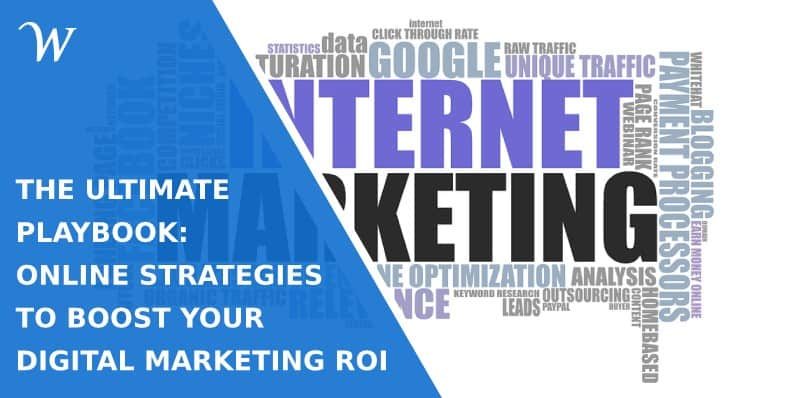The Ultimate Playbook: Online Strategies to Boost Your Digital Marketing ROI
Digital marketing is a dynamic landscape where success is measured not just in visibility but in the return on investment (ROI). Transform your online strategy with an expert digital marketing agency, The Ultimate Playbook provides a comprehensive guide to enhance your digital marketing ROI, covering various strategies and techniques to stay ahead in this ever-evolving digital realm..
I. Introduction
A. Definition of Digital Marketing ROI
Digital Marketing ROI refers to the measurable returns generated from digital marketing efforts. It goes beyond mere website traffic, focusing on the impact of marketing campaigns on business revenue.
B. Importance of Boosting ROI in Digital Marketing
Enhancing ROI is crucial for businesses looking to maximize the efficiency of their digital marketing expenditures. A higher ROI indicates effective strategies that contribute directly to business growth.
II. Understanding Key Metrics
A. Defining Key Performance Indicators (KPIs)
Identifying and monitoring Key Performance Indicators is essential for gauging the success of digital marketing campaigns. KPIs may include website traffic, conversion rates, and customer acquisition cost.
B. Analyzing Conversion Rates
Conversion rates measure the percentage of website visitors who take a desired action, such as making a purchase or filling out a form. Understanding and optimizing conversion rates is pivotal for improving ROI.
C. Exploring Customer Acquisition Cost (CAC)
Customer Acquisition Cost calculates the expenses incurred in acquiring a new customer. Keeping CAC in check ensures that the cost of acquiring customers doesn’t outweigh the revenue they bring.
III. Crafting Compelling Content
A. Importance of High-Quality Content
Compelling content is the cornerstone of successful digital marketing. Quality content not only attracts but also engages and retains the audience, contributing to increased conversions.
B. Leveraging Visual Content
Incorporating visual elements, such as images and videos, enhances the appeal of content. Visuals not only convey information effectively but also leave a lasting impact on the audience.
C. Incorporating Storytelling Techniques
Storytelling creates an emotional connection with the audience, making the brand more relatable. Incorporating storytelling techniques into content helps in building a strong brand narrative.
IV. Social Media Mastery
A. Choosing the Right Social Media Platforms
Selecting the most suitable social media platforms is essential for reaching your target audience. Each platform caters to different demographics and interests, so understanding your audience is key.
B. Implementing Social Media Advertising
Leveraging social media advertising allows for precise targeting and increased visibility. Crafting engaging ad creatives and monitoring campaign performance ensures optimal results.
One of the most effective tools in this regard is the use of customer loyalty cards, which allow businesses to track engagement and offer tailored rewards based on purchase behavior. These cards not only boost repeat business but also provide valuable insights into customer preferences, enabling more targeted marketing.Add after: Loyalty programs incentivize repeat purchases and engagement. Offering exclusive rewards and personalized incentives strengthens the bond between the brand and its customers.
C. Building Community Engagement
Fostering a sense of community on social media enhances brand loyalty. Responding to comments, initiating discussions, and running interactive campaigns keep the audience engaged.
V. Email Marketing Strategies
A. Building an Effective Email List
A quality email list is the foundation of successful email marketing. Implementing ethical strategies to grow and maintain a list ensures that your messages reach interested and engaged recipients.
B. Personalization and Segmentation
Personalizing email content based on customer preferences and behaviors increases relevance. Segmenting the audience allows for targeted campaigns, leading to higher open and click-through rates.
C. A/B Testing for Optimization
A/B testing involves experimenting with different elements in emails to identify what resonates best with the audience. Testing subject lines, visuals, and calls-to-action helps optimize email campaigns.
VI. Search Engine Optimization (SEO) Tactics
A. On-Page SEO Best Practices
Optimizing on-page elements like meta titles, descriptions, and content ensures that your website ranks higher on search engine results pages. Implementing relevant keywords naturally is key.
B. Off-Page SEO Strategies
Building high-quality backlinks from reputable sources enhances your website’s authority. Off-page SEO also involves social media signals and online mentions that contribute to improved rankings.
C. The Role of Keywords in SEO
Strategically incorporating relevant keywords in your content aids search engines in understanding the topic. Conducting thorough keyword research helps identify the terms your audience uses.
VII. Utilizing Paid Advertising
A. Google Ads Essentials
Google Ads provides a powerful platform for targeted advertising. Understanding keyword bidding, ad placements, and ad extensions ensures effective use of the Google Ads platform.
B. Facebook Ads: Targeting and Creatives
Crafting compelling visuals and copy in Facebook Ads is crucial. Utilizing Facebook’s robust targeting options helps reach specific demographics, increasing the effectiveness of your campaigns.
C. Monitoring and Adjusting Ad Campaigns
Regularly monitoring ad performance metrics allows for timely adjustments. Tweaking targeting parameters and ad creatives ensures that your paid advertising efforts yield optimal results.
VIII. Mobile Optimization
A. Responsive Website Design
With a growing mobile audience, ensuring your website is responsive on various devices is imperative. A seamless mobile experience contributes to better user engagement.
B. Mobile-Friendly Content
Adapting content for mobile consumption involves concise copy and visually appealing elements. Mobile-friendly content ensures a positive user experience on smartphones and tablets.
C. Mobile Advertising Techniques
Utilizing mobile-specific advertising formats, such as interactive ads and in-app advertising, maximizes your reach on mobile platforms. Tailoring ad content to mobile users’ preferences is key.
IX. Analytics and Data-Driven Decisions
A. Importance of Analytics in Digital Marketing
Analytics tools provide valuable insights into user behavior and campaign performance. Regularly analyzing data informs strategic decisions and identifies areas for improvement.
B. Utilizing Data to Improve Strategies
Data-driven decision-making involves using analytics to refine digital marketing strategies. This iterative process ensures continuous improvement and better ROI over time.
C. Implementing Google Analytics for Insights
Google Analytics offers a comprehensive set of tools for tracking website traffic, user interactions, and conversion data. Understanding and utilizing these insights refines your overall digital marketing strategy.
X. Retargeting and Remarketing
A. Understanding Retargeting Concepts
Retargeting involves showing ads to users who have previously interacted with your website. This targeted approach keeps your brand in front of potential customers, increasing the likelihood of conversion.
B. Crafting Compelling Remarketing Campaigns
Remarketing campaigns should focus on reinforcing brand messaging and offering incentives to encourage return visits. Creatively engaging with users through remarketing builds brand recall and trust.
C. Balancing Frequency and Relevance
Finding the right balance between ad frequency and relevance is crucial. Avoiding ad fatigue while delivering timely and relevant content ensures a positive user experience.
XI. Influencer Marketing
A. Identifying Relevant Influencers
Choosing influencers whose audience aligns with your target demographic enhances the effectiveness of influencer marketing. Collaborating with influencers can provide authentic and relatable promotion.
B. Building Effective Partnerships
Establishing genuine relationships with influencers fosters trust. Clearly communicating brand values and expectations ensures influencer collaborations align with your digital marketing goals.
C. Measuring Influencer Campaign Success
Utilizing metrics like engagement, reach, and conversions helps measure the success of influencer campaigns. Adjusting strategies based on campaign performance ensures ongoing success.
XII. A/B Testing for Continuous Improvement
A. Implementing A/B Testing in Digital Marketing
A/B testing involves comparing two versions of a webpage, email, or ad to determine which performs better. This iterative process is essential for refining elements and optimizing performance.
B. Testing Variables for Optimization
Testing variables such as headlines, images, and calls-to-action allows for data-driven optimization. Incremental changes based on A/B test results contribute to long-term success.
C. Iterative Testing for Long-Term Success
Embracing an iterative testing approach ensures continuous improvement. Regularly testing and refining digital marketing strategies based on data insights lead to sustained success.
XIII. Building Customer Loyalty
A. Importance of Customer Retention
While acquiring new customers is essential, retaining existing ones is equally crucial. Focusing on customer loyalty leads to repeat business and positive word-of-mouth marketing.
B. Implementing Loyalty Programs
Loyalty programs incentivize repeat purchases and engagement. Offering exclusive rewards and personalized incentives strengthens the bond between the brand and its customers.
C. Encouraging Customer Reviews and Testimonials
Positive reviews and testimonials build trust among potential customers. Actively encouraging customers to share their experiences contributes to a positive online reputation.
XIV. Staying Ahead of Trends
A. Continuous Learning in Digital Marketing
The digital landscape evolves rapidly, and staying informed is key. Continuous learning through industry publications, webinars, and conferences ensures you remain ahead of the curve.
B. Adapting to Industry Changes
Flexibility and adaptability are crucial in the ever-changing digital marketing landscape. Adapting quickly to industry changes positions your brand for sustained success.
C. Embracing Emerging Technologies
Exploring and adopting emerging technologies, such as AI and AR, can give your brand a competitive edge. Embracing innovation keeps your digital marketing strategies fresh and effective.
XV. Conclusion
A. Summarizing Key Strategies
The Ultimate Playbook provides a holistic approach to boosting digital marketing ROI. From understanding key metrics to leveraging the latest trends, implementing these strategies collectively enhances overall performance.
B. Encouraging Ongoing Optimization
Digital marketing is a dynamic field, and ongoing optimization is crucial for sustained success. Regularly review analytics, test new strategies, and adapt to industry changes to ensure continuous improvement.
C. The Path Forward for Digital Marketing Success
By implementing the strategies outlined in The Ultimate Playbook, businesses can navigate the digital landscape with confidence. Consistent effort, creativity, and a data-driven approach pave the way for long-term digital marketing success.
FAQs
- How long does it take to see results from digital marketing strategies?
- Results vary, but some strategies may show initial impacts within weeks, while others require months for optimal results.
- Is influencer marketing suitable for all types of businesses?
- Influencer marketing can be effective for various businesses, but it’s crucial to choose influencers whose audience aligns with your target market.
- What role does mobile optimization play in digital marketing success?
- Mobile optimization ensures a positive user experience, as a significant portion of internet users access content on mobile devices.
- How often should I update my digital marketing strategies to stay relevant?
- Regular updates are essential, especially considering the dynamic nature of the digital landscape. Quarterly reviews and adjustments are a good starting point.
- Are loyalty programs only beneficial for e-commerce businesses?
- Loyalty programs can benefit businesses across industries by fostering customer retention and encouraging repeat business.
- The Corporate Contract Winner: Landing High-Volume B2B Orders with WP Gift Wrap - December 12, 2025
- The Missing Link in WordPress Reliability: A Deep Dive into WP Email Log - November 28, 2025
- Video Trimmer That Lets You Rearrange Scenes Instantly - November 11, 2025
Where Should We Send
Your WordPress Deals & Discounts?
Subscribe to Our Newsletter and Get Your First Deal Delivered Instant to Your Email Inbox.




